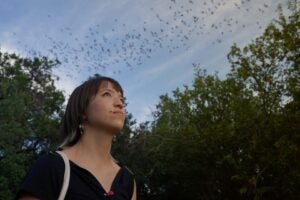AUSTIN, Texas—Woody trees and shrubs encroaching grassland in the United States may be locking up less atmospheric carbon than predicted, according to a new study by a research team including Professor Jay Banner, director of the Environmental Science Institute at The University of Texas at Austin.
“These results will help us figure out how carbon dioxide in the atmosphere gets stored by vegetation and soil in these environments,” said Banner, the Dave P. Carlton Centennial Fellow in Geology in the Department of Geological Sciences. Because increasing levels of carbon dioxide in Earth’s atmosphere are proposed to be a main agent of global climate change, it is essential to determine the amount and distribution of carbon stored in “sinks” such as terrestrial plants, grasses and soil.
When compared to grassy areas, the extra carbon saved in the wood of encroaching trees and shrubs at the wettest locations may be more than offset by the carbon lost from the underlying soil, the research group headed by Duke University environmental scientist Robert Jackson found.
They made their deductions at six experimental field sites from eastern Texas to western New Mexico, where original species of grasses and invading species of woody vegetation could be directly compared. At these sites in Texas, New Mexico and Colorado, grasslands had been invaded by trees and shrubs over the past century.
“Assessments relying on carbon stored from woody plant invasions to balance emissions may therefore be incorrect,” the research team wrote in the Aug 8, 2002, edition of the journal Nature.
“Woody encroachment” has been identified as one of two important factors for an estimate by scientists that the atmospheric carbon sink — amounts of former carbon dioxide gas stored away in various natural repositories — had been “relatively stable” in the United States for more than a decade.
Jackson, Banner and colleagues set out to examine the carbon sink associated with woody plant encroachment in more detail.
Many scientists consider carbon dioxide from human activities a major contributor to global warming. Policy-makers have hoped that growing more trees would help ameliorate the problem.
That’s because some of the carbon from the carbon dioxide is incorporated into the plant material, where it remains until the plants die and decay. In the case of the wood in trees, that carbon may thus remain sequestered for centuries. In the case of grasses, carbon from the plant matter will return to the atmosphere in only a matter of years.
However, another sink for carbon is the soil. The organic carbon in soils can remain in the soil for centuries. Furthermore, the global soil carbon pool is about twice as large as the plant pool.
So while grassy vegetation in itself is no long-term carbon repository, the rich black soils underneath many grasslands can be. And it’s the grasslands once carpeting the southwestern United States that are changing as a result of fire suppression and cattle grazing.
Many of those former grassland environments have since been invaded by drought-tolerant woody tree and shrub species that grow more robustly in the eastern part of their range and more sparsely towards the dryer west.
So Jackson’s research group — which in addition to Banner includes Jackson’s graduate student Esteban Jobbagy, William Pockman of the University of New Mexico and Diana Wall of Colorado State University — focused on the soil underlying what had been southern and western grasslands.
In research supported by the National Science Foundation , the Andrew W. Mellon Foundation and the Geology Foundation of The University of Texas at Austin, Jackson’s group first examined global records comparing amounts of carbon in grasslands, shrublands and woodlands in various climates and environments worldwide.
That data search found that as you move to increasingly wet environments, grasslands have a lot more soil carbon than shrublands and woodlands do. The analysis suggested that sites with the potential to store the most plant carbon also had the potential to lose the most soil organic carbon.
At the six research sites the scientists were able to study the effects of this encroachment because the original grasses had been maintained on one side of a fence running through each test plot, while woody species had invaded the other side of the fence.
The average precipitation levels at those plots spanned the entire range of grasslands in North America, from the edge of the western deserts to the edge of the eastern forests.
The group also probed soils more deeply than previous studies have with the aid of a drilling rig than could penetrate as much as 10 meters down. And they were able to deduce the original sources of the soil carbon because carbon taken in by woody vegetation is different from that processed by grasses.
“We found a clear negative relationship,” the authors wrote in Nature, between the amount of precipitation and changes in soil organic carbon “when grasslands were invaded by woody vegetation.” Drier sites consistently gained soil organic carbon, while wetter sites lost it.
Loses of organic soil carbon at the wetter sites were substantial enough to offset the increased plant biomass carbon stored in the growing wood, they reported.
Why this precipitation-tied carbon loss is occurring is still unclear, though the researchers offered some suggestions. One is that “grasslands send a lot of their carbon below ground, so that carbon goes immediately into the soil.”
In addition to changes in the amount of carbon entering the soil, the quality of the tissue also changes, as woody tissue is typically more difficult to decompose than herbaceous tissue, according to the researchers.
The Nature report said “the most notable shift in carbon from below-ground to above-ground pools was at the wettest site,” in Engeling, Texas. “Such shifts make carbon stocks more vulnerable to loss from fire, biomass (wood) harvesting and other disturbances.”
For more information contact: Dr. Jay Banner, 512-471-5016.



